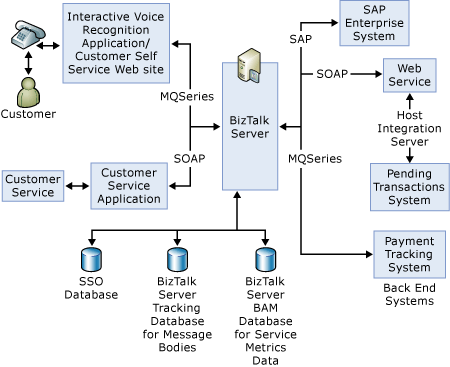Components of the Service Oriented Solution
This section describes the major BizTalk Server components of the Service Oriented Solution. The following diagram shows the major components of the solution:

The Service Oriented solution has three versions of the orchestrations:
A version in which all three of the back-end applications are stubbed out
One in which all three back-end applications are invoked inline
A version that uses adapters to connect to the applications.
All versions of the orchestrations appear in the SDK\Senarios\SO\BTSSoln\Orchestrations directory.
The inline version of the orchestrations provides the lowest latency time within the solution between requests and responses.
For information about the source files, see File Inventory for the Service Oriented Solution.
Orchestrations in the Service Oriented Solution
Three orchestrations, CustomerServiceReceiveSend, CustomerServiceNativeRequestResponse, and CustomerService compose the bulk of the solution. The CustomerServiceReceiveSend and CustomerServiceNativeRequestResponse orchestrations act as front-ends that call the CustomerService orchestration. The CustomerService orchestration does most of the work—sending requests to the back-end applications, gathering the replies, combining the replies into a single message, and sending the message to the appropriate front-end orchestration. Because the front-end orchestrations call the CustomerService orchestration, the front-end orchestrations wait until the CustomerService orchestration finishes.
The solution exposes the CustomerServiceNativeRequestResponse orchestration as a Web service. The CustomerServiceReceiveSend orchestration takes messages from an MQSeries queue.
Back-end Applications
The Service Oriented solution communicates with three back-end applications:
The PaymentTracker application returns a simulated list of recent payments. PaymentTracker reads the request from an MQSeries queue and sends the response to another MQSeries queue.
The PendingTransaction application reports the sum of transactions pending against the customer account. The application is a Web service that, in turn, uses Microsoft Host Integration Server (HIS) to communicate with a CICS/COBOL program on a mainframe computer.
The SAP application provides information about the customer's overall credit limit. The solution connects to the SAP application as a Web service. The application uses the SAP adapter in BizTalk Adapter Pack to communicate with a SAP system.
Pipelines
The Service Oriented solution uses default pipelines except in two places: the receive pipeline for the CustomerServiceReceiveSend orchestration, and the CustomerService orchestration's send pipeline to the PaymentTracker. Both pipelines use custom components.
The receive pipeline for CustomerServiceReceiveSend includes a custom party resolution component, SSO Ticket Issuer Pipeline Component. The messages that the CustomerServiceReceiveSend orchestration receives do not have credentials. This simulates what would happen if the messages came from an Interactive Voice Response system. The custom pipeline component adds credentials using the service account of the BizTalk receive host.
In contrast, the messages the CustomerSericeNativeRequestResponse orchestration receives already have credentials. Because the virtual folder for the Web service is configured for integrated security and the SOAP receive location is configured to integrate Enterprise Single Sign-On (SSO), the SOAP adapter generates a ticket for the message.
The other custom pipeline appears in the CustomerService send pipeline to the PaymentTracker application. The component, MQSeries Header Setter Pipeline Component, sets values for two MQSeries message header properties. The component sets the first, the Message Data Format (MQMD_Format), to indicate the message is in the form of an MQCIH structure, a structure commonly used to communicate with CICS programs. The second, the format of the data itself within the MQCIH structure (MQCIH_Format),is set to show the message is a string.
Using the MQCIH format enables you to pass the user ID and password in the MQCIH structure. SSO affiliate applications map the BizTalk application's Windows user ID to the Payment Tracking System's user IDs passed in the MQCIH structure.
Note
The inline version of the solution uses the same pipelines by calling them from the orchestration. This enables re-use of the pipeline code.
Client Application
The solution includes a client application written in C#. You can use the application to send requests as SOAP or MQSeries messages, and examine the results.
Other Assemblies
The application includes several auxiliary assemblies not shown in the summary diagram above. The Utilities assembly utility functions for the solution.
The ErrorHelper assembly contains classes to translate error codes into messages, and to convert error messages to error codes.
The ServiceLevelTracking assembly includes helper methods using the Business Activity Monitoring (BAM) API to track service-level agreement data.
The ConfigHelper assembly contains helper methods to retrieve configuration values for the solution from the SSOConfigStore application.
See Also
Developing a Service Oriented Solution
File Inventory for the Service Oriented Solution